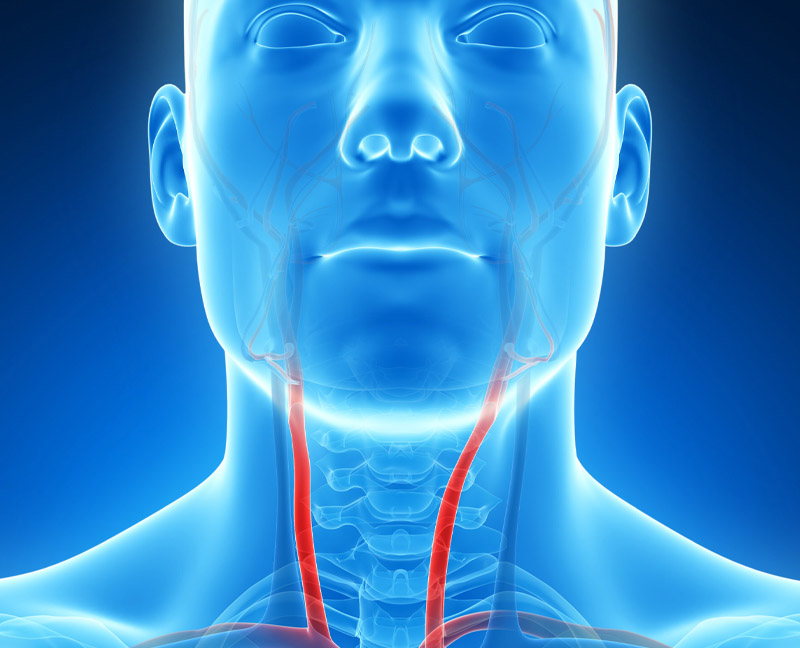The Twenty Minute Screening That Can Save Your Life

The carotid arteries are the main blood vessels from the heart to the brain, supplying it with life-sustaining blood flow. There is a carotid artery on both sides of the neck, each one feeding one side of the brain. When there is carotid stenosis present, meaning the carotid artery is narrowed or blocked by plaque, it can lead to a stroke. According to General and Vascular Surgeon Dr. Matthew Lawrence of Shore Physicians Group in Somers Point, finding any carotid stenosis early is so important. Vascular screening is the number one tool used to find any stenosis or any other irregularity in the arteries and veins. Dr. Lawrence said,“Our goal is to catch any carotid stenosis before it becomes symptomatic.”
Symptoms of carotid stenosis
Dr. Lawrence said symptoms of carotid stenosis are very similar to that of a stroke. There could be weakness on one side, slurred speech, and an inability to grab something, weakness in one arm or leg and even facial droop. “The symptoms are not bilateral. They would appear primarily on one side or the other indicating there may be some blockage. I would want to look further with vascular screening.” Dr. Lawrence said some people may have symptoms that affect their vision. He added, “The blood flow to the back of the eye occasionally will be affected by carotid stenosis. While it might be short-lived, it is an indication of something we need to really look into further to understand why it occurred.”
Stroke statistics
According to the Centers for Disease Control and Prevention, stroke is a leading cause of death in the United States and is a major cause of serious disability for adults. About 795,000 people in the United States have a stroke each year.
Carotid stenosis, along with carotid artery disease, is caused by a buildup of plaques in arteries that deliver blood to the brain. Plaques are clumps of cholesterol, calcium, fibrous tissue and other cellular debris that gather at microscopic injury sites within the artery. Carotid arteries that are clogged with plaques are stiff and narrow. Clogged carotid arteries have trouble delivering oxygen and nutrients to vital brain structures that are responsible for your day-to-day functioning.
Screening for carotid stenosis
Dr. Lawrence says that vascular screening at Shore Physicians Group Vascular Testing and Diagnostics Center is an invaluable tool. “The ultrasound does such a good job in helping to detect any irregularities,” said Dr. Lawrence. “The testing is not stressful, it takes about 20 minutes, and there is no need for an IV and no need for radiation. We are able to take pictures of the patient’s arteries and see what is going on.”
Because ultrasound technology is efficient in helping to detect any narrowing of the arteries, it gives the physician a baseline for the patient. The advantage is being able to plot the best course for the patient.
Managing carotid stenosis
Dr. Lawrence said patients who have some narrowing may be able to manage it medically, at least early on. “If they make some lifestyle changes it will help. If they make the decision to stop smoking, get their blood pressure under control and begin managing their cholesterol level with a statin we can continue to monitor,” said Dr. Lawrence.
Once the ultrasound studies have been done and the carotid artery is significantly narrowed or blocked, surgery is often the only option. Dr. Lawrence said, “The open surgical option, an endarterectomy, is where we open up the carotid artery and put a patch on the artery to permit proper blood flow to the brain, and it really does take care of the problem. It is a quick rebound for the patient. They are normally only in the hospital overnight and go home the next day, most with nothing more than an extra strength Tylenol and bandage on their neck. The risk of any complications is very rare.” The patient returns to have sutures or staples removed in a week to 10 days and again for a checkup in a month, six months and a year as we continue to follow them.”
Getting you back to your life
Dr. Lawrence said patients will ask if they should take it easy. “I tell them, they got the repair so they can get back to their life and I encourage them to do it. If they are used to taking a walk, they should feel comfortable taking a walk. That patch that I put in is very strong and we know it can take the pressure of blood pumping through there, it can certainly handle a walk or going to the gym.”
Managing your numbers
Dr. Lawrence said it is so important for long term health to manage the numbers critical to remaining healthy. “Keep your cholesterol in check, get your blood pressure under control, and watch your diet along with watching the scale. Right now we have an epidemic of obesity. We have too many people, even young people in their 20s and 30s who are sedentary, and the long term effect is unhealthy. Get up and get some exercise every day,” concluded Dr. Lawrence.
To make an appointment with Dr. Matthew Lawrence or to be evaluated for vascular screening at the Shore Physicians Group Vascular Testing and Diagnostic Center, call 609-365-6239.